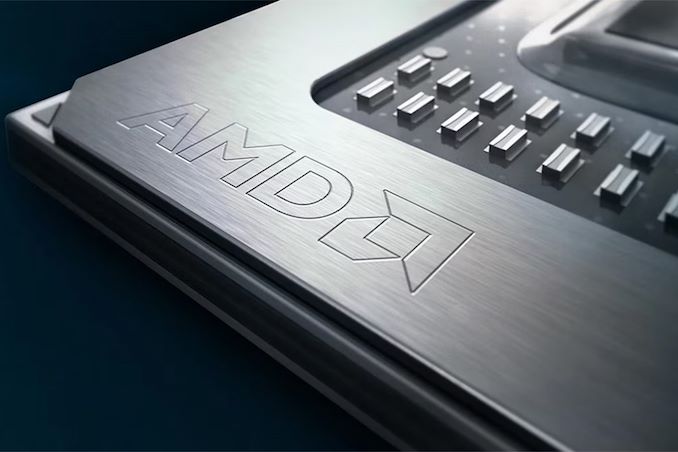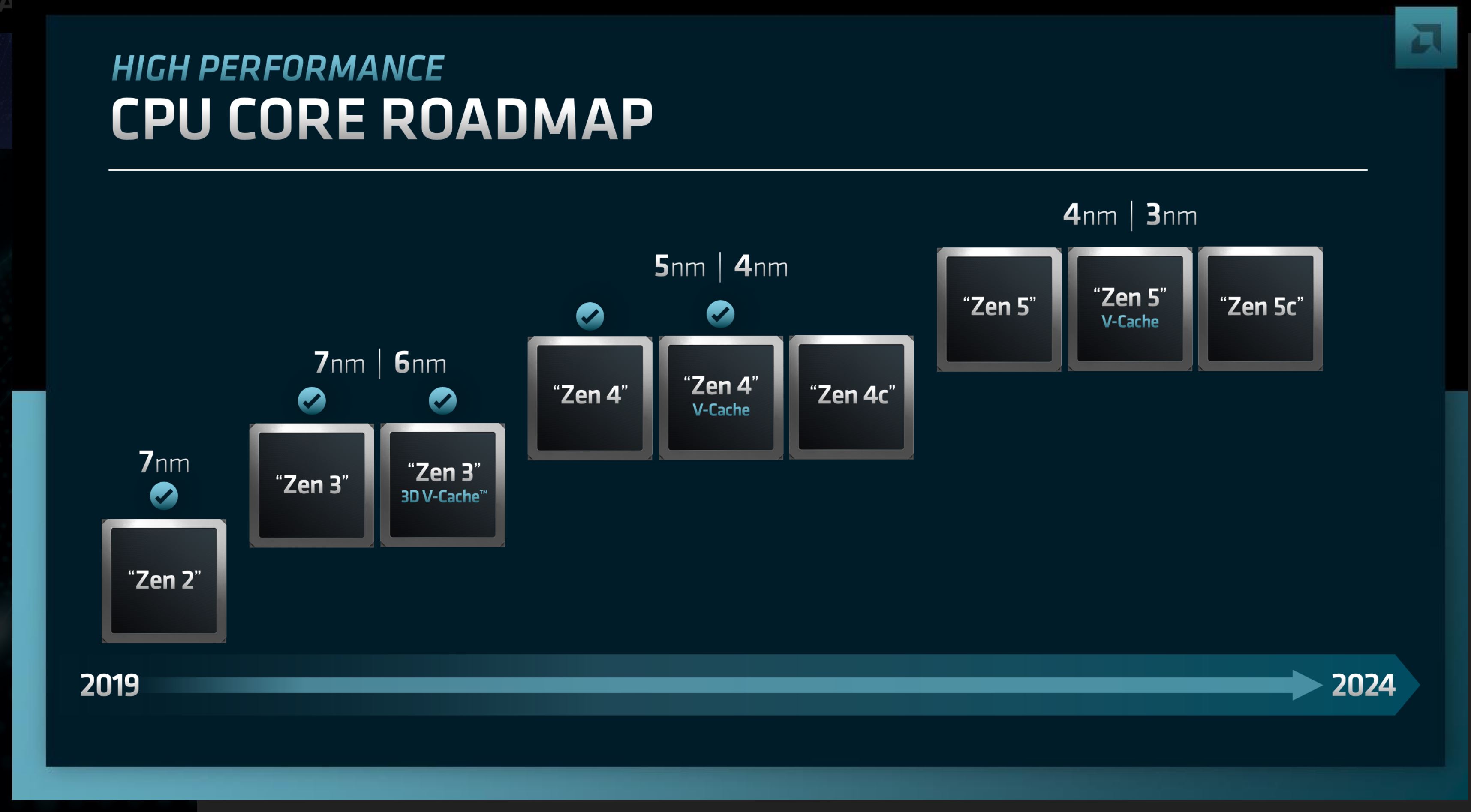AMD: Zen 5-Based CPUs for Client and Server Applications On-Track for 2024
by Anton Shilov on February 2, 2024 10:30 AM EST
As part of their quarterly earnings call this week, AMD re-emphasized that its Zen 5-architecture processors for both client and datacenter applications will be available this year. While the company is not making any new disclosured on products or providing a timeline beyond "later this year", the latest statement from AMD serves as a reiteration of AMD's plans, and confirmation that those plans are still on schedule.
So far, we have heard about three Zen 5-based products from AMD: the Strix Point accelerated processing units (APUs) for laptops (and perhaps eventually desktops), the Granite Ridge processors for enthusiast-grade desktops, and Turin CPUs for datacenters. During the conference call with analysts and investors, AMD's Lisa Su confirmed plans to launch Turin and Strix this year.
"Looking ahead, customer excitement for our upcoming Turin family of EPYC processors is very strong," said Lisa Su, chief executive officer of AMD, at the company's earnings call this week (via SeekingAlpha). "Turin is a drop-in replacement for existing 4th Generation EPYC platforms that extends our performance, efficiency and TCO leadership with the addition of our next-gen Zen 5 core, new memory expansion capabilities, and higher core counts."
The head of AMD also confirmed that Turin will be drop-in compatible with existing SP5 platforms (i.e., will come in an LGA 6096 package), feature more than 96 cores, and more memory expansion capabilities (i.e., enhanced support for CXL and perhaps support for innovative DIMMs). Meanwhile, the new CPUs will also offer higher per-core performance and higher performance efficiency.

AMD High Performance CPU Core Roadmap. From AMD Financial Analyst Day 2022
As far as Strix Point is concerned, Lisa Su confirmed that this is a Zen 5 part featuring an 'enhanced RDNA 3' graphics core (also known as Navi 3.5), and an updated neural processing unit.
"Strix combines our next-gen Zen 5 core with enhanced RDNA graphics and an updated Ryzen AI engine to significantly increase the performance, energy efficiency, and AI capabilities of PCs," Su said. "Customer momentum for Strix is strong with the first notebooks on track to launch later this year."
It's notable that the head of AMD did not mention Granite Ridge CPUs foe enthusiast-grade desktops during the conference call. Though as desktop CPUs tend to have smaller margins than mobile or server parts, they are often AMD's least interesting products to investors. Despite that omission, AMD has always launched their consumer desktop chips ahead of their server chips – in part due to the longer validation times required on the latter – so Turin being confirmed for 2024 is still a positive sign for Granite Ridge.
Source: AMD/SeekingAlpha










23 Comments
View All Comments
ikjadoon - Friday, February 2, 2024 - link
Please do double-check the headline. It states 2025, while the text states 2024.Ryan Smith - Friday, February 2, 2024 - link
I don't know what you're talking about. It has always said "2024", and there is now no evidence to the contrary. =P(Seriously though, thank you. We caught this one right after the article went live, but not quite fast enough for your eagle eyes!)
NextGen_Gamer - Friday, February 2, 2024 - link
I'm really excited about these. As always, rumors tend to get a bit TOO crazy with expectations, but right now those rumors are saying this is biggest IPC jump in Zen history. That, along with the Strix Point rumor pointing towards a 16 CU RDNA-3.5 iGPU, another big jump over the current 12 CU RDNA-3 one, has got me super hyped for AMD's launches this year.AMD's slide says a mixture of 4-nm/3-nm for the Zen 5 chips. I'm guessing Granite Ridge and Turin will be 4-nm (an upgrade from current 5-nm), while Strix Point will be monolithic 3-nm (an upgrade from current 4-nm).
schujj07 - Friday, February 2, 2024 - link
I've been waiting for Zen 5 to upgrade my 10.5 year old 4770k system. Thought about Zen 3 but didn't want to be on the tail end of DDR4 like I was with DDR3. Zen 4 was a bit too expensive early on and by the time prices dropped enough it isn't long to Zen 5.CrystalCowboy - Friday, February 2, 2024 - link
I'm holding out for Zen 7.Rοb - Saturday, February 3, 2024 - link
Yes 7nm vs 5nm is .71 smaller, or 1.4 times as much stuff.While 5nm vs 3nm is .6 smaller (and .43 smaller than 7nm, for 2.3X), or 1.6 times as much stuff.
But, when we get to 1 or 2nm, along with the necessary architecture changes (to use so small a node), that's when we'll have not just stacked cache but stacked CPUs (and NPUs) that will be so much faster (combined with the certainty of more than 6096 pins, for PCIe 6 and CXL 3.x).
Worth waiting for PCIe 6, waiting for Zen 7 is a few years away; but the huge cache and NPU will be interesting. 🤔
Terry_Craig - Sunday, February 4, 2024 - link
On chips with a lot of cache, 3nm offers just over 20% compared to 4nm.CrystalCowboy - Monday, February 5, 2024 - link
"While 5nm vs 3nm is .6 smaller (and .43 smaller than 7nm, for 2.3X), or 1.6 times as much stuff."That's in one dimension. Semiconductors are two-dimensional. So 3nm vs 5nm should fit up to 2.77 times more stuff.
nandnandnand - Monday, February 5, 2024 - link
I hope both of you realize that the node names are marketing names and there's no point doing calculations based on the node number anymore. You have to look at published information about density. Recent nodes have mediocre scaling and SRAM isn't scaling at all at TSMC (for the moment).TSMC's optimization of N3E, N3P, should have about 1.66x the logic density of N5, with no improvement (1x) for SRAM.
nandnandnand - Saturday, February 3, 2024 - link
You should keep Zen 4 on the table after Zen 5 comes out, if whatever you want (e.g. 7800X3D) becomes really cheap. There have already been some good bundle deals too (Newegg).